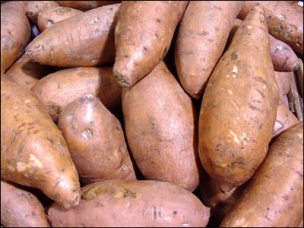From Gardening
Solutions
Institute of Food and Agricultural Sciences, University of Florida
Sweet Potatoes
Native to the Americas, sweet potatoes are known for
their colorful and tasty tubers. Their flesh can be yellow, orange, or
even purple. They're an excellent source of vitamin A and a good source
of vitamin C.
Sweet potatoes (Ipomoea batatas) are a great warm season crop for
Florida. They require a long growing season, but will reward you
greatly for your patience.
Something you may not know about these popular potatoes is that the
leaves are edible as well! Not only are they nutritious, the young
leaves and shoots can provide you with a source of tender and
mild-tasting leafy greens through the hot Florida summer.

Planting and Care
Sweet potatoes can be planted in the spring through the end of June.
They grow well in sandy soil and don't require much fertilizing.
Sweet potatoes are typically started from transplants called "slips."
Slips are baby plants that sprout from a mature sweet potato. While you
could grow sweet potatoes slips yourself, it is always a good idea to
start out with certified disease-free plants or vine cuttings from a
reputable garden supply. Sweet potato weevils can be a serious problem
and starting out with certified-free transplants can help you avoid
issues.
Look for transplants that are about 6 to 9 inches long. Plant your
sweet potatoes in rows spaced 48 to 54 inches apart with 12 to 14
inches between each plant. Sweet potatoes will do best when they
receive a consistent supply of water often; inconsistent watering can
cause your sweet potatoes to split while growing.
You can keep your sweet potatoes going throughout the season by using
vine cuttings to create new plants.
Right plant, right place
Nematodes can sometimes be a problem in Florida, so consider having
your soil tested before you plant. You can reduce disease problems with
your sweet potatoes by having a two-year rotation between your crops.
Rotating where you plant can help prevent problems with a major pest,
the sweet-potato weevil (Cylas formicarius).
For the tastiest sweet potatoes, always dig up the previous crop and
start a new planting. While sweet potatoes can be grown in tropical
regions year-round, plants that are left to grow for too long can
encourage pest populations, and the sweet potatoes eventually become
too large and tough for most people's tastes.
Pick Florida-friendly varieties
'Centennial' and 'Beauregard' are two varieties that grow well in
Florida gardens. Gardeners with less space should consider 'Vardaman',
a bush type of sweet potato that's great for smaller gardens.
Harvesting Your Sweet Potatoes
It will be nearly four months before your sweet potatoes are ready to
harvest. To help increase their sweetness, place harvested sweet
potatoes in a dark, warm room for at least two weeks before eating.
This allows some of the starch in the roots to convert to sugar. The
ideal conditions for curing sweet potatoes is roughly 85°F with 90
percent humidity.
Once your sweet potatoes are done curing, store them in a cool, dry
pantry—not the refrigerator! Storing your sweet potatoes at
temperatures below 50°F can cause them to have an off flavor, or worse,
rot.
Patience will pay off with delicious and healthy sweet potatoes that
will be equally at home on the dinner plate as a vegetable side or in a
sweet pie served for dessert. And remember, while the word "yam" is
sometimes used to describe the sweet potato, a true yam comes from a
totally different plant.
|
|
